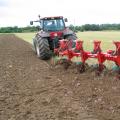Is it true that ABS reduces braking distances?
it
not always like this. For example, during braking on slippery road ABS
Provides vehicle handling by preventing wheel locks
(i.e. preventing the car from skidding to brake). In this case, the braking distance
may increase.
Also, braking distance with ABS may increase.
when braking on loose snow, on a slippery slope. But definitely
answer the question of how a car with ABS (or without it) will behave
in case of emergency braking, it is impossible.
It all depends on the driving speed, weather conditions, road surface, the type of tires installed and the skill of the driver.
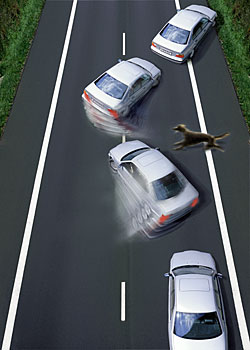 What are ABS?
What are ABS?
IN
the most expensive, and therefore the most efficient systems, each wheel
has individual pressure regulation brake fluid.
Naturally, the number of sensors angular velocity, modulators
pressure and control channels in this case is equal to the number of wheels.
Cheap
ABS is bypassed with two sensors per rear wheels, one common
modulator and one control channel. The most widely used
system with four sensors, but with two modulators (one per
axis) and two control channels. There is also a three-channel
system with four yaw rate sensors. Three modulators of this
systems serve three channels, making individual regulation
brake fluid pressure in the lines of the front wheels separately
and both rear wheels.
The latest ABS with a computer
the dynamics of vehicle movement, the angle of inclination of the road
roadbed, grip, the influence of the included
cruise control when decelerating the car and other factors, and on
Based on this data, the control unit regulates the pressure in the brake
highways. Having determined the magnitude of the pressure, it is provided by supplying or
bleeding brake fluid into the accumulator.
And if the car is equipped with ABS, then ice is not terrible for it?
Neither
in any case. ABS system (as well as ESP, and other systems of active
security) only reduces the likelihood of losing control over
by car, but does not guarantee safe driving in any conditions
and at any speed.
More confident driving on ice
contributes to the condition of the tread and the type of tires (by the way, there are models
tires specially designed for vehicles with ABS), driving style and
the skills of the driver himself. Therefore, in any situation you need to correctly
choose the distance and speed of movement regardless of whether it is equipped
whether your car is electronic assistants.
How the ABS system works
System
ABS consists of a main unit, which on many cars with this
system can be seen by looking under the hood. This block is connected
metal tubes with brake cylinder and braking system.
Each wheel of a car equipped with ABS has a speed sensor; in
the system also includes the electronic unit management (tracking
slip of each wheel individually) and hydraulic cylinder
(distributing braking forces).
The principle of operation is
as follows: under heavy braking, the usual brake system blocks
wheels, ABS, during hard braking, monitors the blocking and
releases the wheels, thus maintaining control over
by car. In this case, sufficiently strong vibrations occur on the pedals.
brakes, and a characteristic sound is heard. All this is not worth paying attention to
attention, as these signs indicate normal operation
systems.
ABS prevents the driver from braking correctly, only harm from it!
it
the most common misconception. Anti-lock braking system brakes
(ABS) is by far the most widely used system
increasing traffic safety. For almost all new cars
this system is installed in basic configuration... ABS is very useful and
effective, the main thing is to learn how to use it correctly.
ABS
the latest generation allows the driver to maintain stability
driving directions even in the worst traffic situations. And complementary
ABS electronic assistants allow you to achieve greater efficiency
braking.
So, for example, there are systems that increase
pressure in the brake system during emergency braking, and electronic
regulators that optimize the braking distance by redistributing
pressure in the brake circuits of all four wheels (in
depending on the vehicle load and the condition of the road surface).
If the ABS is faulty, the brakes are faulty
it
not this way. With a faulty ABS brake the system works as usual. ABOUT
when the ABS system is triggered, the driver recognizes the
braking inscriptions on the instrument panel and the characteristic pedal jolts
brakes.
If the inscription on dashboard burns constantly, then this
indicates that the system is faulty due to a breakdown, or that
that it is disabled.
How to use ABS
Actually
ABS simulates the actions of an experienced driver who is on a slippery road
avoids wheel blocking by using intermittent braking. Drivers
the Kremlin garage used this method emergency braking still
before the invention of anti-lock braking systems and could make up to 7 clicks
(braking) per second. ABS makes about 15 braking cycles per
second, such a frequency is not available to humans.
As a result
anti-lock braking system provides the car with minimum braking
path and makes it manageable in braking - after all, the wheels roll and
perceive lateral force as far as the grip of the tires with
coated. And this is the main advantage of ABS. After all, with blocked
the car is practically not controllable by wheels.
Professional
experienced driverswho know firsthand what ABS is, at
high speed in summer or on a slippery road in winter, they use the technique
braking "to the floor". It consists in the following: you press with all your might
on the brake, not paying attention to pedal vibration and unpleasant
sound, and as a result you get a good deceleration, while having
the ability to maneuver without losing control of the car.
The most
the main thing is not to be afraid to press the pedal all the way. If your car
equipped with ABS, be sure to practice, otherwise in
in an emergency, you may not react. To do this, you can choose
quiet calm area and try at a speed of about 40 km / h sharply
brake while turning wheel... A little workout, and
you can easily avoid obstacles while braking using
ABS.
Please be aware that braking a vehicle with ABS is not
should be multiple and intermittent. The brake pedal is necessary
keep pressed with considerable effort during the braking process
- the system itself will provide effective deceleration.
There is also a misconception - ABS does not turn off
it
Not certainly in that way. On many cars aBS system can be disabled,
by de-energizing the electronic control unit (i.e. remove the fuse or
relay), while the braking system will work properly.
And, for example, on some audi models and VW even has a button on the panel that disables the ABS system.
ABS makes the car uncontrollable
it
not this way. On the contrary, ABS prevents the wheels from locking in an emergency
braking, thereby helping to maintain directional stability and
the ability to drive while braking (for example, to
go around the obstacle).
Based on materials from the Russian press: kolesa.kz
With the onset of winter, the tension on the roads increases significantly, since it is no longer possible to drive on a snow-covered and sometimes icy road in the "summer" mode, and not every car owner can quickly change his driving style. Due to the lack of constant and high-quality grip of the wheels with the road surface, braking, especially in emergency situations, can lead to loss of control over vehicle... Therefore, with the onset of cold weather, you should at least change the aggressive driving style to a more relaxed one.
Experienced car owners with many years of experience do just that, while beginners learn from their mistakes. In order to feel more confident on a slippery and icy road, constant practice is necessary, since all theoretical advice taken together will not allow you to gain the required experience, feel the car, and intuitively feel the approaching danger. It should be understood that despite the equipment modern cars various systems that help in control, for example, ABS, you should not blindly rely on them.
ABS - help or hindrance on ice
Equipping cars with driving assistance systems led to the fact that many, especially inexperienced drivers, began to trust her too much, forgetting many points safe driving... It should not be forgotten that with the onset of frost, the rubber should be replaced with studded versions - this significantly reduces the brake pressure even on a slippery road. In order to know how to properly brake with ABS, you should get acquainted with the principle of operation of this system, which is designed to prevent the wheels from locking when braking and losing control of the vehicle.
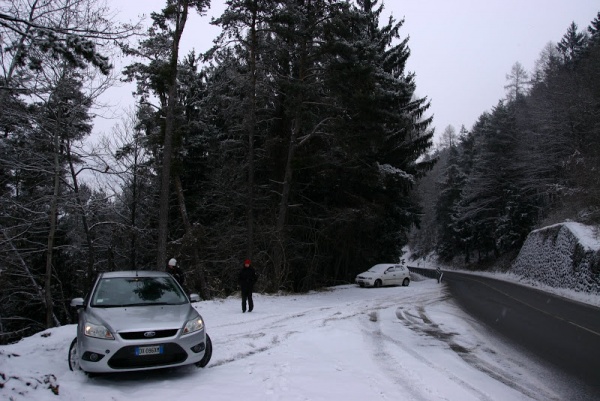
When trying to brake hard on a standard car without ABS, the wheels are simply blocked, which leads to a sharp decrease in controllability and skidding of the vehicle. It is worth noting that between the blocked tire and the road surface, the friction force will be quite weak, so a quick stop of the car is almost impossible on a slippery road. Braking that is carried out without blocking is more effective than sliding on an icy road surface. In addition, it prevents uncontrolled slipping and skidding of the vehicle. The pros and cons of ABS are described in detail in the video:
To know how to brake with the ABS with maximum efficiency, you need to understand the principle of operation of this system, which is quite simple. On each of the hubs of the car with ABS there are special projections like the teeth of a gear. When the car is moving, they move under inductive sensors, which transmit impulses to the car control system. There are several sensors, and when the wheel stops rotating during braking, the transmission of impulses stops, the bypass valves are triggered and the braking force weakens. It is at this moment that the driver hears a characteristic crackling sound. Thus aBS system prevents wheel locking, allowing the driver to control the process of driving.

How to brake properly on a car equipped with ABS
Before dealing with the question - how to properly brake in winter on front wheel drive, we should remember the simple rules of "winter" behavior on the road, which are often neglected by modern drivers:
- maintain a distance that differs from the summer one by a slightly larger distance;
- the tires must correspond to the season - not necessarily studded, but it is unacceptable to continue to operate the car on summer tires in winter;
- avoid sudden braking when making maneuvers, especially when entering corners;
- do not apply excessive pressure on the brake pedal when the car overcomes obstacles / bumps in the road surface.
The last point is especially relevant for vehicles with ABS. Do not naively believe that if the car is new and expensive, all the security systems and driver assistance available in it will help maintain control in a critical situation, when the driver himself does not show elementary attention to the road situation. In addition, there are some features, in addition to the above, that will allow braking on ice with ABS more correctly. These include the following:

Attention! The absolute efficiency of the ABS decreases sharply on surfaces such as sand, ice, pronounced irregularities - braking on them should be carried out taking into account the fact that the ABS may work incorrectly.
How to brake correctly in winter on mechanics
When braking in winter timewhen the road is icy or snowy, it must be understood that the braking distance is significantly increased, and measures to stop the car should be started in advance. It is most optimal to use a combined method of braking, that is, in addition to the brake pedal, a gearbox should be used, especially if the distance allows. Such braking includes not only pressing the brake pedal, but also downshifting.
But it should be understood that the gears should be lowered gradually, with the corresponding indicators on the speedometer - if you suddenly switch to a low gear when the car speed is high, there is a possibility of "knocking down" the engine, which will lead to a complete loss of control. In winter, it is necessary to completely forget about such a braking technique as "pedal to the floor". This is not only ineffective, but also dangerous, since when the wheels are locked, driving becomes almost impossible.

To know how to brake on ice if the car is not equipped with ABS, you should remember how this system works. Apply the brake often and intermittently when you need to quickly reduce speed to avoid loss of control and brake. It is very important to stay calm on slippery roads and avoid harsh brake pedal and steering wheel movements, bearing in mind that such actions in most cases contribute to the loss of control over the car.
Special attention to difficult road sections
If traffic takes place predominantly in urban areas, special care must be taken at intersections. They pose an increased danger even in summer period, in winter accident risk here it rises many times over. In order to properly brake with ABS in winter, the process must be started several tens of meters before the very intersection. It is enough to lightly press the brake pedal, allowing the ABS to do the rest.
If the car brakes with jerks, do not panic - this is a normal phenomenon, and any actions of the driver at this moment can prevent a quick stop. At intersections, special care must be taken not only at the time of stopping. You should not strive to start one of the first, as soon as the red starts blinking. Other contributors road traffic may easily fail to complete the maneuver and stop moving completely, especially if their car is not equipped with ABS.
The further into the forest, the more firewood, and the more more modern car, the more questions it raises. Anti-lock braking system (abbreviated as ABS) - since 2004 it is installed by default on all new european cars... But what does it give the driver, why is it good and why is it bad? As our experience in driver training shows, these questions are not answered by all, even very experienced drivers. And as is often the case with driving a car, there are various myths around the ABS. In this article, I want to put everything in its place ...
ABS has been triggered - tires have reached the grip limit
To begin with, the ABS is activated only during emergency braking. Emergency braking - braking in which the car decelerates as quickly as possible and travels the shortest possible braking distance. To realize the maximum possible deceleration, you need to brake so that the tires roll on the verge of sliding, on the verge of locking the wheels with the brakes. Why exactly "rolled" and "on the verge of sliding"? Because, in simple terms, the tire "clings" more strongly to the road when it rolls than when it slides.
No need to dose pedal effort
How to achieve braking on the verge of wheel locking? How can you calculate the force of your foot on the brake pedal so accurately? Very simple! This is where the antilock braking system comes to our rescue. From the name it is clear that this system does not allow the wheels to lock for a long time, no matter how hard you press the brake pedal, and thereby ensures deceleration on the verge of sliding tires along the road. Although, to be precise, it sometimes admits: at a speed below 5 km / h, as well as when the car slides sideways, it simply turns off. I.e ABS gives us a very valuable opportunity - the opportunity not to think about how to brake.
Ability to steer when braking
What else do we have good, thanks to the ABS? The main advantage of a car with ABS is the ability to change the direction of travel during emergency braking using the steering wheel. Actually, this is what the ABS was invented for. On a car without ABS, it is impossible to maneuver with the brake pressed to the floor: despite the rotation of the steering wheel, the car will continue to move straight ahead with enviable persistence.
At the same time, one must understand that there are no miracles and the laws of physics cannot be circumvented. This I mean, although the ABS allows you to steer, but when the brake is pressed on the floor, the car drives much worse than with the brake pedal released... Yes, you will be able to rebuild into the next lane, but no more! And the lane change will take much longer, which means that the car will cover a much greater distance during this time than without braking.
The reverse is also true: the braking distance during emergency braking with ABS is minimal when the steering wheel "looks" straight ahead, and increases when trying to change the direction of travel.
Shorter braking distance? How to say…
There is an opinion among drivers that the main task of the ABS is to shorten the braking distance of the car compared to the braking distance without the ABS. This is not entirely true.
First, you cannot compress the incompressible. If the brakes are in good working order, then in the absence of ABS, they can easily block the wheels, which means they can reach the peak deceleration. Recall that the maximum deceleration of the car is achieved precisely on the verge of sliding tires on the road, and it does not matter in what way - with or without ABS. The emergency braking distance of a vehicle is determined by the adhesion of the tires to the road. And on the same road, the braking distance will be shorter for a car with better tires, and not with ABS or without ABS, or with larger brake discs or with small ones. Read more about this in the articles “Physics of braking: does the braking distance really depend on the mass of the car? "And" Is the tire grip independent of the contact patch area? "
Another thing is that without the ABS it is easier to make a mistake, to cross this line and to put the car in the "skid". But this is already a matter of the driver's skill. So the ABS cannot fundamentally change the situation; it only, we repeat, makes it possible not to think and not to dose the effort of the leg during braking. As they say, "hit the brakes - and forget!".
Secondly, in practice, the braking distance with ABS is even noticeably longer than without ABS. For example, when braking on a loose surface (snow, soil, gravel, etc.), a car with ABS brakes as usual.
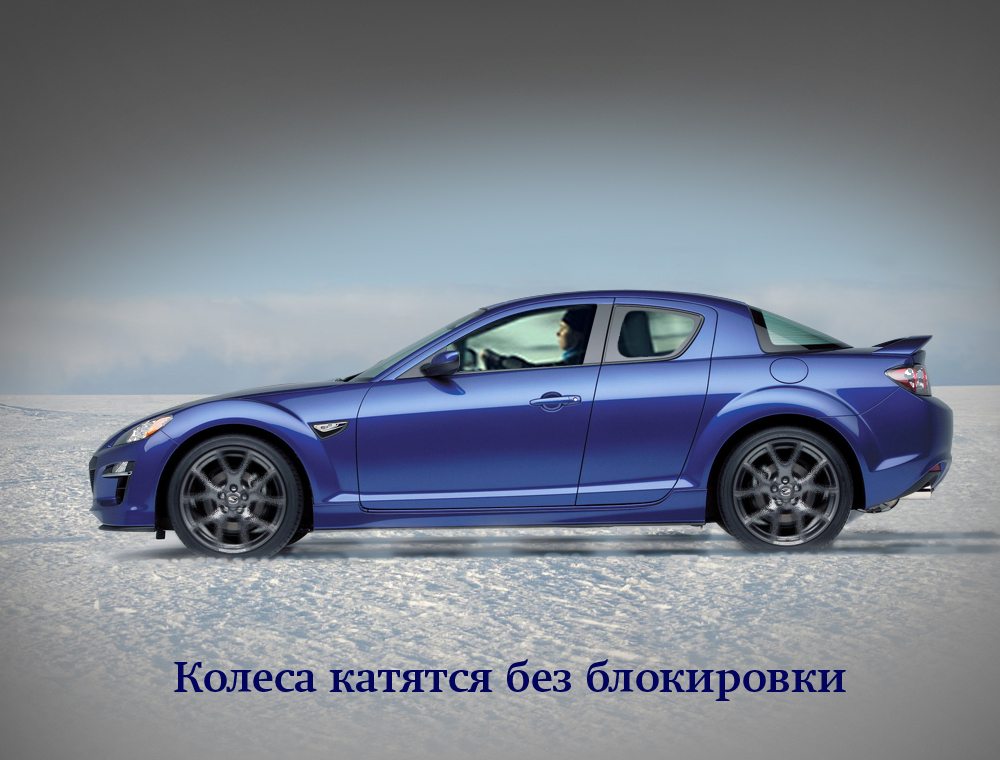
And without ABS, it’s not quite usual: the wheels are blocked and rake in front of them, like a bulldozer, a hill, which creates additional resistance to the movement of the machine. It turns out shorter!

True, the most modern ABS is so "smart" that it seems that they have already learned how to cope with these tasks and brake as efficiently as possible on different surfaces. However, today there is an overwhelming minority of cars with such ABS.
Maintaining directional stability when braking
Another "trick" ABS is that she prevents the car from skidding during braking... Imagine this situation: a car without ABS is moving at high speed with its left wheels on an asphalt road, and with its right wheels along the side of wet grass. Wet grass is very slippery compared to asphalt, and the tires "cling" to it much weaker. Therefore, if the driver presses the brake on the floor, then the wheels on the asphalt (left) will quickly slow down, and on the grass (right) will be blocked. That in an instant will lead to a skid and rotation of the car, by the way, in the direction of the oncoming lane.

Unless, of course, the driver is not an ace and does not have time to release the brake pedal in half this moment and correct the trajectory of the steering wheel. Of course, the ABS would have prevented the right wheels from locking and the subsequent skidding of the car.
Benefits of ABS. Outcomes
As a result, we have the following advantages from the presence of ABS during emergency braking and its amazing ability to prevent the brakes from locking the wheels:
- you do not need to think about how to brake and dose the effort on the brake pedal;
- you can change the trajectory of the vehicle during emergency braking;
- in most cases, you stop the car on the shortest possible stretch of road;
- short braking distance is provided not by the ABS as such, but by high-quality tires and good road surface... ABS does not allow the braking distance to lengthen, but it cannot shorten and make it shorter than on a car without ABS;
- you retain the stability and controllability of the car, especially when there are sections of the road of different "slipperiness" under the wheels on the right and left.
Good afternoon, dear reader.
In the fourth article of the series "Vehicle Security Systems", we will consider another security mechanism - anti-lock braking system.
Unlike the systems considered earlier passive safety (and) that help in accident case, anti-lock braking system refers to systems active safety , i.e. it mainly helps to prevent collisions between cars.
The easiest way to brake a car
Many drivers believe that in order to quickly stop the car, it is necessary to press and hold the brake pedal (brake to the floor). Of course, this method will make the car stop, but such braking will not be effective.
When braking to the floor, wheel lock, i.e. the wheels of the car stop turning. At first glance, it seems that with the wheels locked, the car will stop faster. But this is only at first glance. Let us recall a small element of the school physics course: "The force of static friction is always greater than the force of sliding friction." Those. if the wheels of the car are rolling (unlocked), the car will brake faster than in the case of locked wheels. This is due to the fact that in the first case, the contact patch of the car wheels is located in stationary relative to the roadway, i.e. the force of friction at rest acts. In the second case, when the wheels of the car are blocked, the force of sliding thorns acts on it.
There is also a second disadvantage of the simplest braking method - a car with locked wheels completely loses control... Those. if the wheels are locked while cornering, the car will continue to move by inertia straight ahead, and not towards the turned wheels.
It's obvious that the simplest way braking is imperfect and sometimes dangerous. Therefore, to assist the driver when braking, special anti-lock braking systems (ABS).
Anti-lock braking system
As you might guess from the name, the anti-lock braking system does not allow the wheels of the car to lock when braking.
In the simplest case, the system consists of sensors that measure the rotation speed of each of the wheels and a control unit. In this case, the speeds of rotation of the wheels are compared, and if one of the wheels rotates more slowly than the others (a sign of blocking), then the braking force on this wheel decreases. The wheel is not locked. The ABS system checks the wheels dozens of times per second, which makes it possible to maintain the same rotation speed for all wheels.
Obviously, when using ABS in the case of braking to the floor the braking distance of the vehicle is reducedand, just as importantly, the car remains steerable.
Braking by intermittent pressing on the brake pedal
There is one more method of braking, which can be used both with and without ABS - braking by intermittent pressing of the brake pedal. It consists in the fact that the driver presses the brake pedal sharply, strongly, but for short periods of time. Those. he presses the pedal, then releases it.
With such braking, the wheels of the car are locked-unlocked. This method allows you to reduce the braking distance of the vehicle. This is due to the fact that when the brake pedal is pressed for a short time, the weight of the car is transferred to its front axle. Also, when the brake pedal is released, the car remains steerable.
There is a controversial opinion that if a person knows how to brake intermittently, then he does not need an ABS system. While intermittent braking can reduce the stopping distance, it does have a drawback. In order to critical situation to brake in this way, it is necessary to intermittently brake constantly. This will develop the appropriate skill. But with intermittent braking, the car sways strongly and, therefore, constantly braking in this way is uncomfortable for the driver. And even more so, the constant buildup will not please your passengers!
Well, since the ABS system itself works at the moment of hard braking, it is an indispensable assistant in any car.
Cars with ABS
Since 2016, all cars put into circulation, including domestic ones, are mandatory equipped with an anti-lock braking system.
Driving school training is enough to graduate car roads new driver. At the same time, during the course of training, the future motorist does not learn practically anything directly about driving a car, memorizing the rules and performing exercises on the training ground. Finding himself on real roads and purchasing his first car, the driver may face the problem of the absence or presence of anti-lock brakes. It is important to be able to correctly stop a car at high speed, which is equipped with ABS systems or at which it is absent.
 From the very name "anti-lock braking system" we can conclude that it is necessary to prevent the wheels from locking. It is installed on most modern cars, but some drivers deliberately turn it off, noting that without it it is more convenient to control the braking process of the car. Also, this system can fail during operation, which will signal the driver. If it lights up while driving, you should remember how to brake properly without ABS, otherwise there is a great risk of collision with other cars.
From the very name "anti-lock braking system" we can conclude that it is necessary to prevent the wheels from locking. It is installed on most modern cars, but some drivers deliberately turn it off, noting that without it it is more convenient to control the braking process of the car. Also, this system can fail during operation, which will signal the driver. If it lights up while driving, you should remember how to brake properly without ABS, otherwise there is a great risk of collision with other cars.
Experienced drivers, who often drive cars without anti-lock braking systems, subconsciously sense the moment when a slightly stronger pedal pressure will lead to the car "skidding". Correct braking on a car without ABS in city traffic is intermittent frequent pressing of the pedal. By applying the brake and releasing it, the driver avoids the option of locking the wheels, in the event of which the car risks becoming uncontrollable.
At the same time, hard braking on a car without ABS is different from slowing down in normal driving. If you urgently need to slow down or stop the car in order to avoid an obstacle on the road, you can choose one of the following methods:

The main principle when braking a car without ABS is smooth operation with the brake pedal. Sharp pressing on it or a sudden release will lead to loss of stability of the car.
 Anti-lock braking system simplifies the braking process for inexperienced drivers, allowing them not to think about how to press the brake pedal to stop the car and it does not lead to the side. A vehicle with an ABS system does not change direction if the brake pedal is depressed and not released. The system prevents the wheels from locking, and the driver can turn the steering wheel without fear if it is necessary to overcome an obstacle on the road. In fact, this system simulates the process of intermittent pressing of the pedal.
Anti-lock braking system simplifies the braking process for inexperienced drivers, allowing them not to think about how to press the brake pedal to stop the car and it does not lead to the side. A vehicle with an ABS system does not change direction if the brake pedal is depressed and not released. The system prevents the wheels from locking, and the driver can turn the steering wheel without fear if it is necessary to overcome an obstacle on the road. In fact, this system simulates the process of intermittent pressing of the pedal.
If hard braking is necessary on a car with ABS, press the brake pedal into the floor and apply force to it until the car slows down to the required speed or stops completely. If you press the pedal smoothly, the system ABS car may not work at all, and the braking performance will be reduced.
 Braking the car on automatic box gears can hardly raise questions, while with mechanics it is a little more complicated. Remember following ruleshow to brake on mechanical box gear:
Braking the car on automatic box gears can hardly raise questions, while with mechanics it is a little more complicated. Remember following ruleshow to brake on mechanical box gear:
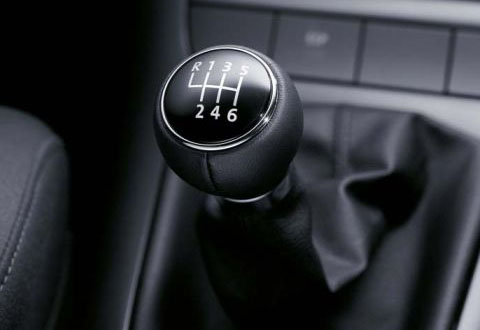
Every motorist should be able to correctly brake on any type of clutch with or without ABS. The safety of the driver, his passengers and surrounding motorists depends on the correct braking mode.




